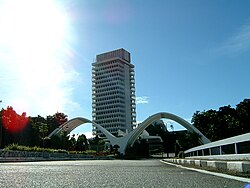This article needs additional citations for verification .(March 2014) |
| Occupational Safety and Health Act 1994 | |
|---|---|
 | |
| Parliament of Malaysia | |
| |
| Citation | Act 514 |
| Territorial extent | Malaysia |
| Passed by | Dewan Rakyat |
| Passed | 20 October 1993 |
| Passed by | Dewan Negara |
| Passed | 16 December 1993 |
| Royal assent | 15 February 1994 |
| Commenced | 24 February 1994 |
| Effective | 25 February 1994 |
| Legislative history | |
| First chamber: Dewan Rakyat | |
| Bill title | Occupational Safety and Health Bill 1993 |
| Bill citation | D.R. 26/1993 |
| Introduced by | M. Mahalingam, Deputy Minister of Human Resources |
| First reading | 18 October 1993 |
| Second reading | 19 October 1993 |
| Third reading | 20 October 1993 |
| Second chamber: Dewan Negara | |
| Bill title | Occupational Safety and Health Bill 1993 |
| Bill citation | D.R. 26/1993 |
| Member(s) in charge | M. Mahalingam, Deputy Minister of Human Resources |
| First reading | 13 December 1993 |
| Second reading | 16 December 1993 |
| Third reading | 16 December 1993 |
| Related legislation | |
| Merchant Shipping Ordinance 1952 [Ord. No. 70 of 1952] Merchant Shipping Ordinance 1960 of Sabah [Sabah Ord. No. 11 of 1960] Merchant Shipping Ordinance 1960 of Sarawak [Sarawak Ord. No. 2 of 1960] Factories and Machinery Act 1967 [Act 139] | |
| Keywords | |
| Occupational safety and health, occupational disease, occupational injury, work accident, safety culture | |
| Status: In force | |
The Occupational Safety and Health Act 1994 (Malay : Akta Keselamatan dan Kesihatan Pekerjaan 1994) is a piece of Malaysian legislation which governs the safety, health and welfare of workers during work.
Contents
- Structure
- List of regulations under this Act
- National Council for Occupational Safety and Health
- See also
- References
- External links
The principle of the Act is "To make further provision for securing that safety, health and welfare of persons at work, for protecting others against risks to safety or health in connection with the activities of persons at work, to establish the National Council for Occupational Safety and Health and for matters connected therewith."
The Act applies throughout Malaysia to the industries specified in the First Schedule. Nothing in this act shall apply to work aboard ships governed by the Merchant Shipping Ordinance 1952 [Ord. No. 70 of 1952], the Merchant Shipping Ordinance 1960 of Sabah [Sabah Ord. No. 11 of 1960] or Sarawak [Sarawak Ord. No. 2 of 1960] or the armed forces.